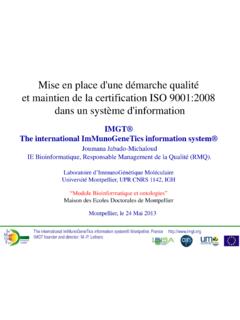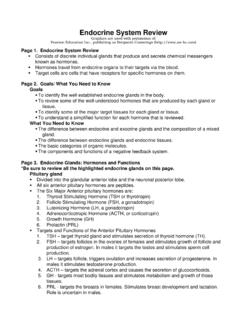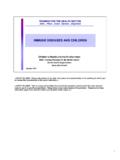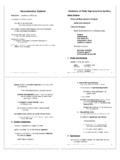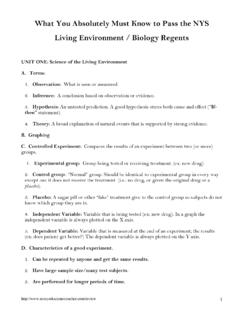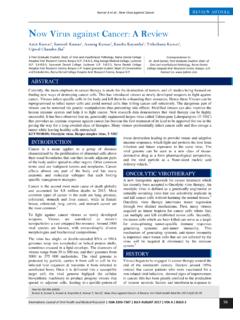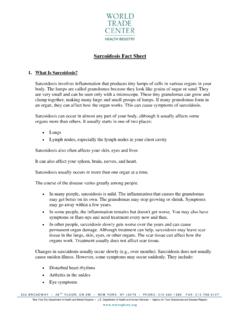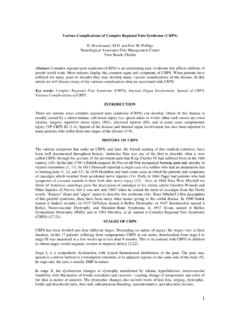Transcription of Understanding the Immune System: How it works - …
1 Understanding the Immune system How It works DEPARTMENT OF HEALTH AND HUMAN SERVICES NATIONAL INSTITUTES OF HEALTH National Institute of Allergy and Infectious Diseases National Cancer Institute Understanding the Immune system How It works DEPARTMENT OF HEALTH AND HUMAN SERVICES NATIONAL INSTITUTES OF HEALTH National Institute of Allergy and Infectious Diseases National Cancer Institute NIH Publication No. 03-5423 September 2003 Contents 1 Introduction 2 Self and Nonself 3 The Structure of the Immune system 7 Immune cells and Their Products 19 Mounting an Immune Response 24 Immunity: Natural and Acquired 28 Disorders of the Immune system 34 Immunology and Transplants 36 Immunity and Cancer 39 The Immune system and the Nervous system 40 Frontiers in Immunology 45 Summary 47 Glossary IntroductionThe Immune system is a network ofcells, tissues*, and organs that worktogether to defend the body against attacksby foreign invaders.
2 These are primarilymicrobes(germs) tiny, infection-causingorganismssuch as bacteria, viruses,parasites, and fungi. Because the humanbody provides an ideal environment formany microbes, they try to break in. It isthe Immune system s job to keep them outor, failing that, to seek out and destroy the Immune system hits the wrongtarget or is crippled, however, it canunleash a torrent of diseases, includingallergy, arthritis, or Immune system is amazingly can recognize and remember millions ofdifferent enemies, and it can producesecretions and cells to match up with andwipe out each one of secret to its success is an elaborateand dynamic communications and millions of cells , organizedinto sets and subsets, gather like clouds ofbees swarming around a hive and passinformation back and forth. Once immune1 Bacteria:streptococciFungus: penicillium moldParasite:schistosomeVirus: herpes virus*Definitions of words printed in italics are listed in theGlossary on page receive the alarm, they undergo tactical changes and begin to produce powerful chemicals.
3 These substances allow the cells to regulate their own growth and behavior, enlist their fellows, and direct new recruits to trouble spots. Self and Nonself The key to a healthy Immune system is its remarkable ability to distinguish between the body s own cells self and foreign cells nonself. The body s Immune defenses normally coexist peacefully with cells that carry distinctive self marker molecules. But when Immune defenders encounter cells or organisms carrying AntibodyAntigen uleMarker molecAntigens carry marker molecules that identify them as foreign. 2 markers that say foreign, they quickly launch an attack. Anything that can trigger this Immune response is called an antigen. An antigen can be a microbe such as a virus, or even a part of a microbe. Tissues or cells from another person (except an identical twin) also carry nonself markers and act as antigens. This explains why tissue transplants may be rejected. In abnormal situations, the Immune system can mistake self for nonself and launch an attack against the body s own cells or tissues.
4 The result is called an autoimmune disease. Some forms of arthritis and diabetes are autoimmune diseases. In other cases, the Immune system responds to a seemingly harmless foreign substance such as ragweed pollen. The result is allergy, and this kind of antigen is called an allergen. The Structure of the Immune system The organs of the Immune system are positioned throughout the body. They are called lymphoid organs because they are home to lymphocytes, small white blood cells that are the key players in the Immune system . 3 adenoids nodes nodes vessels Appendix Bone marrow us Spleen patches nodes vessels Tonsils and Lymph Lymph Lymphatic ThymPeyer s Lymph Lymphatic The organs of the Immune system are positioned throughout the body. Bone marrow, the soft tissue in the hollow center of bones, is the ultimate source of all blood cells , including white blood cells destined to become Immune cells . The thymus is an organ that lies behind the breastbone; lymphocytes known as 4 center Medulla Vein Outgoing lymph vessel Incoming lymph vessel Germinal Follicle Artery Paracortex Cortex The lymph node contains numerous specialized structures.
5 T cells concentrate in the paracortex, B cells in and around the germinal centers, and plasma cells in the medulla. T lymphocytes, or just T cells , mature in the thymus. Lymphocytes can travel throughout the body using the blood vessels. The cells can also travel through a system of lymphatic vessels that closely parallels the body s veins and arteries. cells and fluids are exchanged between blood and lymphatic vessels, enabling the lymphatic system to monitor the body for invading microbes. The lymphatic vessels carry lymph, a clear fluid that bathes the body s tissues. 5 Small, bean-shaped lymph nodes are laced along the lymphatic vessels, with clusters in the neck, armpits, abdomen, and groin. Each lymph node contains specialized compartments where Immune cells congregate, and where they can encounter antigens. Immune cells and foreign particles enter the lymph nodes via incoming lymphatic vessels or the lymph nodes tiny blood vessels.
6 All lymphocytes exit lymph nodes through outgoing lymphatic vessels. Once in the bloodstream, they are transported to tissues throughout the body. They patrol everywhere for foreign antigens, then gradually drift back into the lymphatic system , to begin the cycle all over again. The spleen is a flattened organ at the upper left of the abdomen. Like the lymph nodes, the spleen contains specialized compartments where Immune cells gather and work, and serves as a meeting ground where Immune defenses confront antigens. Clumps of lymphoid tissue are found in many parts of the body, especially in the linings of the digestive tract and the airways and lungs territories that serve as gateways to the body. These tissues include the tonsils, adenoids, and appendix. 6 node Lymph Lymphatic vessel Immune cells and foreign particles enter the lymph nodes via incoming lymphatic vessels or the lymph nodes tiny blood vessels. Immune cells and Their Products The Immune system stockpiles a huge arsenal of cells , not only lymphocytes but also cell-devouring phagocytes and their relatives.
7 Some Immune cells take on all comers, while others are trained on highly specific targets. To work effectively, most Immune cells need the cooperation of their comrades. Sometimes Immune cells communicate by direct physical contact, sometimes by releasing chemical messengers. The Immune system stores just a few of each kind of the different cells needed to recognize millions of possible enemies. When an antigen appears, those few matching cells multiply into a full-scale army. After their job is done, they fade 7 Antigen-binding site chain Light chain Heavy Variable region Constant region An antibody is made up of two heavy chains and two light chains. The variable region, which differs from one antibody to the next, allows an antibody to recognize its matching antigen. away, leaving sentries behind to watch for future attacks. All Immune cells begin as immature stem cells in the bone marrow. They respond to different cytokines and other signals to grow into specific Immune cell types, such as T cells , B cells , or phagocytes.
8 Because stem cells have not yet committed to a particular future, they are an interesting possibility for treating some Immune system disorders. Researchers currently are investigating if a person s own stem cells can be used to regenerate damaged Immune responses in autoimmune diseases and Immune deficiency diseases. B Lymphocytes B cells and T cells are the main types of lymphocytes. B cells work chiefly by secreting substances called antibodies into the body s fluids. Antibodies ambush antigens circulating the bloodstream. They are powerless, however, to penetrate cells . The job of attacking target cells either cells that have been infected by viruses or cells that have been distorted by cancer is left to T cells or other Immune cells (described below). 8 B cell Plasma cell Antibody B cells mature into plasma cells that produce antibodies. Each B cell is programmed to make one specific antibody. For example, one B cell will make an antibody that blocks a virus that causes the common cold, while another produces an antibody that attacks a bacterium that causes pneumonia.
9 When a B cell encounters its triggering antigen, it gives rise to many large cells known as plasma cells . Every plasma cell is essentially a factory for producing an antibody. Each of the plasma cells descended from a given B cell manufactures millions of identical antibody molecules and pours them into the bloodstream. 9 An antigen matches an antibody much as a key matches a lock. Some match exactly; others fit more like a skeleton key. But whenever antigen and antibody interlock, the antibody marks the antigen for destruction. Antibodies belong to a family of large molecules known as immunoglobulins. Different types play different roles in the Immune defense strategy. Immunoglobulin G, or IgG, works efficiently to coat microbes, speeding their uptake by other cells in the Immune system . IgM is very effective at killing bacteria. IgA concentrates in body fluids tears, saliva, the secretions of the respiratory Immunoglobulins tract and the digestive tract guarding the entrances to the body.
10 IgE, whose natural job probably is to protect against parasitic infections, is the villain responsible for the symptoms of allergy. IgD remains attached to B cells and plays a key role in initiating early B-cell response. 10 T cells Unlike B cells , T cells do not recognize free-floating antigens. Rather, their surfaces contain specialized antibody-like receptors that see fragments of antigens on the surfaces of infected or cancerous cells . T cells contribute to Immune defenses in two major ways: some direct and regulate Immune responses; others directly attack infected or cancerous cells . Helper T cells , or Th cells , coordinate Immune responses by communicating with other cells . Some stimulate nearby B cells to produce antibody, others call in microbe-gobbling cells called phagocytes, still others activate other T cells . Killer T cells also called cytotoxic T lymphocytes or CTLs perform a different function. These cells directly attack other Mature helper T cell T cell Mature cytotoxic Immature T cell Some T cells are helper cells , others are killer cells .

